Amarnath Yatra 2024: Pilgrims urged to take precautions amid unpredictable weather, high-altitude risks
Wajahat Shabir. Updated: 6/28/2024 3:51:13 AM
Front Page

SRINAGAR: As the annual Shri Amarnath Ji Yatra approaches, the Directorate of Health Services, Kashmir, has released a comprehensive health advisory for the pilgrims.
This year's yatra begins on June 29.
The advisory emphasizes the importance of proper preparation, acclimatization, and awareness of potential health risks associated with the high-altitude pilgrimage. The advisory highlights the unpredictable weather conditions along the pilgrimage route and the health risks posed by high altitudes.
Pilgrims are advised to dress appropriately for the journey, taking along adequate woolen clothing, including jackets, warm inners, woolen socks, gloves, caps, trousers, mufflers, sleeping bags, windcheaters, raincoats, and waterproof shoes. The advisory also suggests carrying an umbrella due to the often unpredictable weather on the track.
One of the key recommendations is to ascend slowly and take frequent breaks, especially on steep inclines, to avoid overexertion. Longer rests at Yatra campsites are encouraged, and pilgrims are advised to adhere to the ideal walking times displayed on boards along the route.
Staying hydrated is crucial; thus, pilgrims are encouraged to drink plenty of water to combat dehydration and headaches. A diet rich in carbohydrates is recommended to reduce fatigue and maintain energy levels, while oily and fatty meals should be avoided.
The advisory strongly discourages staying overnight at the Holy Cave due to the high altitude and harsh weather conditions. In case of altitude illness, pilgrims are instructed to descend immediately to a lower elevation to acclimatize.
The health advisory lists several symptoms that require immediate medical attention, including dizziness, fatigue, headache, loss of appetite, nausea, rapid pulse, cyanosis, chest tightness, confusion, cough, coughing up blood, decreased consciousness, gray or pale complexion, difficulty walking, and shortness of breath at rest. Health facilities have been set up approximately every two kilometers along the shrine routes to assist pilgrims experiencing these symptoms.
Ignoring any of these symptoms can be fatal, and the Directorate of Health Services urges pilgrims to prioritize their health and safety during the Yatra. The comprehensive guidelines aim to ensure a safe and spiritually fulfilling pilgrimage experience for all devotees.